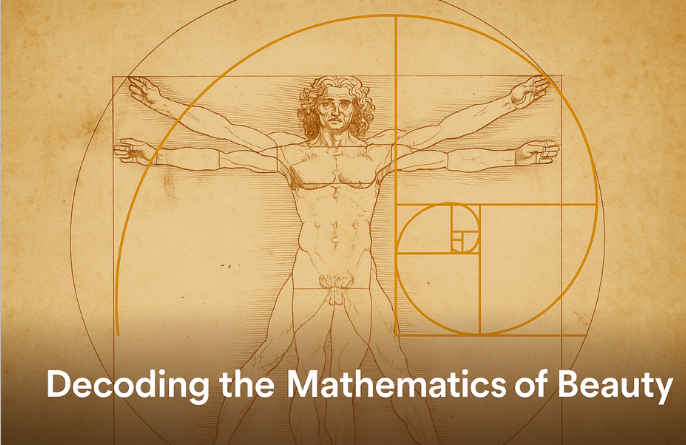The Golden Ratio: A Sacred Code to Beauty in 2025
Over five centuries ago, Leonardo da Vinci attempted to approximate the ideal of human beauty with his now-iconic sketch, Vitruvian Man. To the casual observer, it was just a pen-and-ink drawing—far less famous in his lifetime than the Mona Lisa, and never intended as a grand museum piece. Unlike his painted masterpieces, the Vitruvian Man was likely a private study, not a public statement. But of course, that’s speculation. No one can truly know the mind of a man long since passed.
And yet, beyond speculation—beyond even the drawing’s simplicity—lies a sweeping implication: that beauty may not be random at all. That there may be an architectural principle to the human form, one that can be uncovered like a scientific law.
Da Vinci believed such a principle existed. He called it the Golden Mean.
In the Vitruvian Man, the human body is segmented by this proportion: “The height of the man is in golden proportion from the top of his head to his navel and from his navel to the bottom of his feet.” The drawing reflects the divine proportions Da Vinci believed were embedded within the human being.
He used the Golden Mean not only in this sketch, but throughout his other works—including the Mona Lisa.
Da Vinci and the Golden Ratio in Modern Culture
The connection between Da Vinci and the Golden Ratio has been discussed for generations, but it exploded into mainstream awareness in 2003 with the publication of The Da Vinci Code by Dan Brown. The bestselling novel introduced millions to the idea that beauty, art, and even sacred mystery could be encoded in mathematics—particularly in the Fibonacci sequence and the Golden Ratio.
Source: GoldenNumber.net
Da Vinci was a genius ahead of his time, but not all of his ideas bore fruit. Still, the worldwide success of The Da Vinci Code points to something deeper—our enduring fascination with “making sense of the sacred.” In this context, the sacred refers to the secret code of beauty.
Are the Secrets Written in the Stars?
To the ancient Greeks, beauty wasn’t a matter of opinion—it was as real and discoverable as the orbit of the moon. Pythagoras, famed for his theorem, also believed in a sacred geometry underlying the natural world. He found evidence of this divine structure in everything from the flight of bees to the arrangement of planets.
In the 21st century, this fascination hasn’t waned. Media and science alike have explored the role of the Golden Ratio in:
- The spiral shape of seashells
- The geometry of flower petals
- The proportions used by cosmetic surgeons
- And even the orbits of galaxies
Source: Discover Magazine, 2007
Now, as of 2025, researchers continue exploring whether physical beauty can be broken down into a predictive formula. Can facial symmetry really be quantified? Can artificial intelligence, cosmetic surgery, or even predictive algorithms construct “perfect” faces?
The Golden Proportion and the Face
According to one 2012 study cited in the Daily Mail, a woman’s face is considered most attractive when:
- The distance between the pupils is just under half the width of the face
- The distance between the eyes and mouth is just over a third of the distance from the hairline to chin
Source
If you Google “the math of beauty” today, you’ll find tens of millions of results—over 58 million as of this writing. Interest in this idea is global and growing.
One publication put it simply:
“The magical proportions gave us the facades of the Parthenon and Notre Dame, the face of the Mona Lisa, the Stradivarius violin, and the iPhone.”
Another, Golden Meaning (published by GraphicDesign&), enlisted 55 artists and designers to explore and demystify the Golden Ratio through creative illustration and modern typography.
So What Exactly Is the Golden Mean?
At its core, it’s a mathematical ratio:
a/b = (a+b)/a
This yields an irrational number approximately equal to 0.61803398875, also known as phi (φ).
It may not look mystical at first glance, but its appearances in nature and art have captivated minds for millennia. And it continues to show up in unexpected places—sunflowers, pinecones, galaxies, and human faces alike.
Can Beauty Be Proven Mathematically?
In Western scientific tradition, proof is everything. Yet ironically, many of the most enduring ideas in math remain unproven or unprovable. Pi (π), for example, is a transcendental number—its full implications still elusive.
Beauty, too, resists clear definition. It is deeply subjective and culturally shaped. Standards evolve across generations, continents, and ideologies. Yet despite this variability, we find recurring patterns—shapes and proportions that show up again and again, across history and across species.
The Golden Ratio is one of those patterns.
And perhaps Da Vinci was onto something when he built his life’s greatest works upon it.

